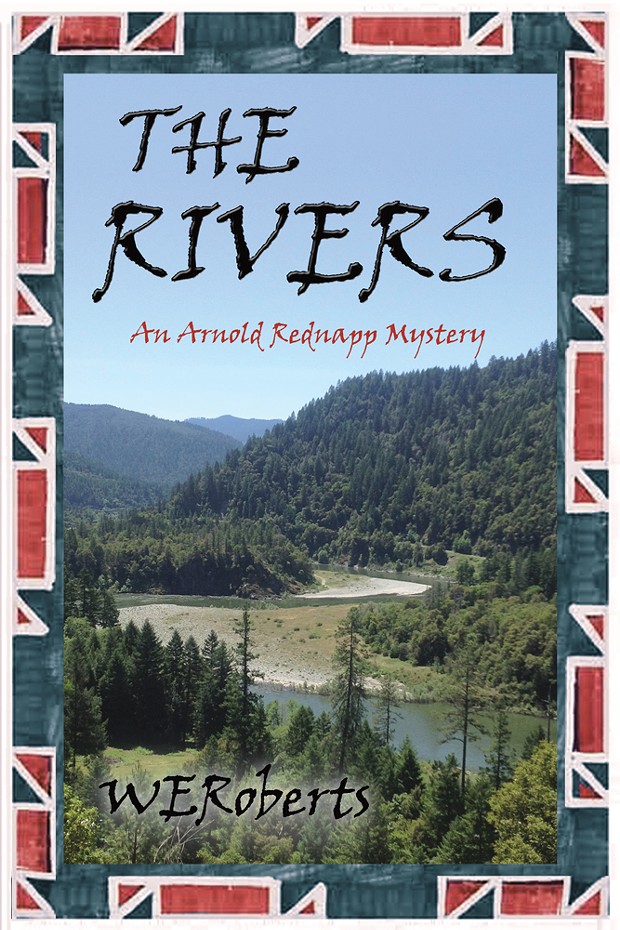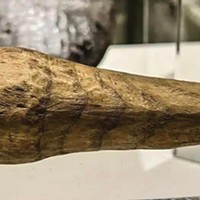
The Rivers by W.E. Roberts.
[
{
"name": "Top Stories Video Pair",
"insertPoint": "7",
"component": "17087298",
"parentWrapperClass": "fdn-ads-inline-content-block",
"requiredCountToDisplay": "1"
}
]
Zooming from London, W.E. Roberts said of his new novel The Rivers, which is set in Humboldt County, "The book was written because I'm an actor, because I like a good story and I thought there was a story there," Roberts explained, leaning forward into the screen. "I'm really an actor who came to writing late — an actor who writes. And I write for fun. The thing that has been wonderful is that people enjoy what I do."
His voice is every bit as plummy and sonorous as you would expect from an actor who has worked on both sides of the Atlantic, spent years reading American novels on the BBC and voiced "heavy" characters in video games.
Born in Roseberg, Oregon, Roberts grew up there and on the Smith River near Crescent City. At Del Norte High School, he got involved in community theater and discovered a talent for accents. Studying drama at Humboldt State University led to a five-year stint as actor and director at the Oregon Shakespearean Festival in Ashland, which led in the late 1960s to a transatlantic move to pursue acting. Roberts has lived in London since, building a resume of films and television series including Cold Mountain, Martin Chuzzlewit, Deathwish III, The Old Devils and Inspector Morse, in addition to voice work.
Researching The Rivers, his third book, gave him a reason to return to the landscapes of his childhood, staying at the Sandy Bar Ranch in Orleans and making forays to Somes Bar, Weitchpec, Klamath, Happy Camp, Shelter Cove and other local spots that appear in these pages. The result is an entertaining tale that's equal parts mystery, travel narrative and historical fiction.
Like Roberts' two previous mysteries, The Rivers is largely narrated by Arnie Rednapp, a San Francisco-based investigative journalist. Charlotte Wilcox Taylor hires Rednapp to get to the bottom of family rumors regarding her possible Native forebears. The mystery surrounding her biological mother's foster parent, Laura Virginia Mayhew, stems from travels to northeastern Humboldt County around 1900 to work for the Bureau of Indian Affairs as a schoolteacher. She departed abruptly two years later, a mixed-race adopted daughter — Charlotte's mother — in tow.
The affable Arnie proves good company as his yarn transports readers from a San Francisco drawing room to the densely forested, mountainous and river-cloven Karuk lands of northeastern Humboldt County, here referred to as "the Rivers." There, the story gets darker as his research project leads to passages of Northern California history involving the culturally sanctioned, racially motivated and frequently murderous forms of oppression meted out for generations by white colonists toward Native inhabitants.
While Rednapp's research touches on history, the present-tense narrative emphasizes the resilience of Native culture and the progress Indigenous communities have made in recent decades, asserting rights over land and waterways, and recovering traditional cultural and spiritual practices as powerful tools with which to redress the fallout from genocide and generations of cultural damage.
The Rivers is more ambitious than Roberts's earlier works, with a parallel structure that cuts between past and present. Rednapp's case cracks open with Laura Mayhew's previously unread diary, written on the Rivers in the early 1900s, which becomes an epistolary device with excerpts interwoven with Rednapp's discoveries.
The dialogue-driven prose proves well suited to narrating events in Arnie's timeline, though it's less convincing ventriloquizing voices from the past. Characterization of these figures is often accomplished in broad, speedy strokes. As pastiche, Mayhew's voice lacks specificity and the quirky tropes of casual early 20th-century American speech that animate Mabel Reed and Mary Ellicott Arnold's In the Land of the Grasshopper Song (one of Roberts' historical sources) are largely absent from the diary entries. Printing those sections in a modified cursive script accentuates this divergence, for better and worse.
Characters based on historical figures from Humboldt's distant or recent past make the novel something of a roman à clef for local readers. The Somes Bar miner and sawmiller Luther Hickox, born in 1873, appears, and contemporary cultural leaders including the late Amos Tripp inspired some depictions of latter-day figures in Karuk lands.
The Rivers is dedicated to the Karuk, Yurok, Hoopa and Tolowa tribes, and it's enhanced by its author's familiarity with and respect for Native culture. Roberts presents Indigenous cultural practice with care, incorporating Native and regional voices. He prefaces the narrative with a poem by Will C.S. Harling of the Mid-Klamath Watershed Council, closes it with a poem by Shaunna Oteka McCovey from The Smokehouse Boys, reproduces a geometric band design by Brian D. Tripp on the cover and thanks a long list of tribal and community leaders for help with the research process.
Mystery fans may read The Rivers as an entertaining whodunit, while others may be drawn to its account of one woman's search for her Native origins. But the implicit message of Roberts's book makes it an especially timely read in 2020. Arnie's investigations present a gentle yet compelling case regarding America's need to come to grips with the realities of its past — even, or especially, the shameful and disturbing parts — in order to move beyond its legacy.
"The truth about our history has been ignored for so long," Roberts said. "It's really important that we embrace that. And I think the more we expose these things to scrutiny, the more we can express them in human form, the better. We need to expand empathy, you know? We need for people to get in other people's shoes and travel part of their way in order to have change.
"A story that people can relate to," he concluded, smiling, "can help with that."
is available at most local bookstores and can be ordered through Amazon.
Gabrielle Gopinath (she/her) is an art writer, critic and curator based in Arcata. Follow her on Instagram at @gabriellegopinath.
Speaking of...
-

A Brief History of Dildos
Apr 11, 2024 -

'Our Food is Our Medicine'
Mar 28, 2024 -

The Reluctantly Famous Shoshoni Hostler
Feb 15, 2024 - More »
more from the author
-
Nancy Tobin's CRy-Baby Installation at CR
- Feb 22, 2024
- More »































